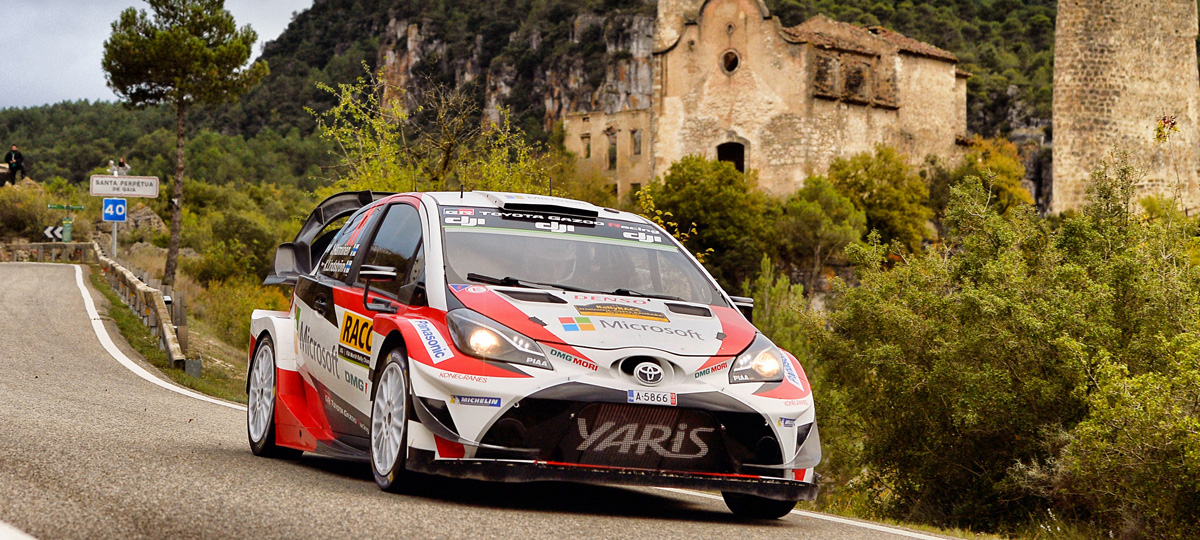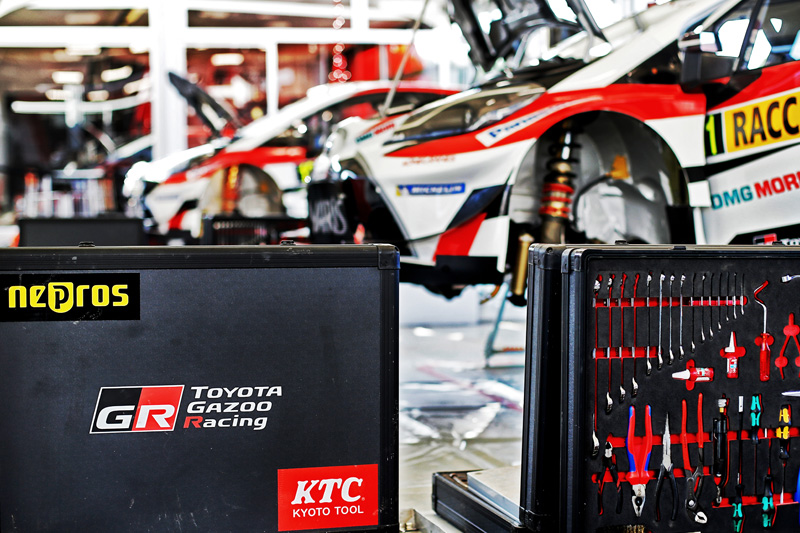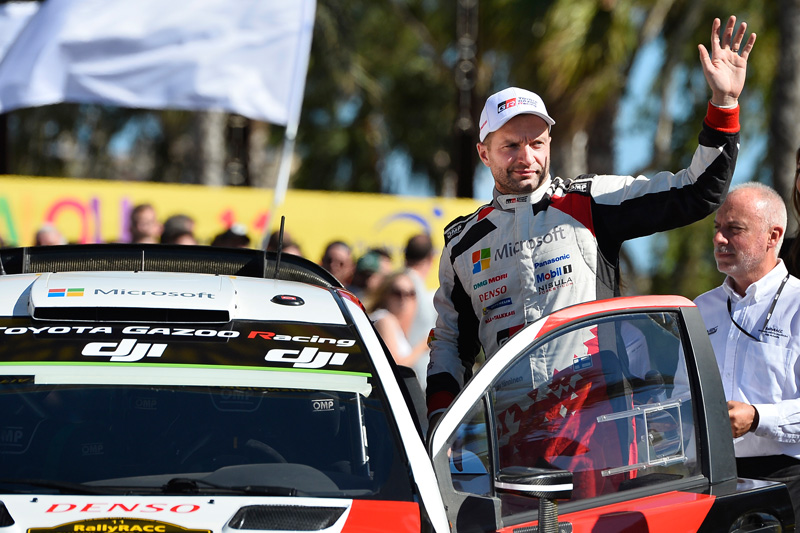RALLY DE ESPAÑA

The steady evolution of Hänninen and the Yaris WRC, as seen on the high-speed tarmac SSs of the Rally de España
Rally de España is the only mixed surface rally in the WRC. It is called a mixed surface rally because drivers ride over two types of surfaces – gravel (uneven dirt roads) and tarmac (paved roads). Although the Rallye Monte-Carlo, the opening rally that is held in January, includes both snowy roads and tarmac, it is classified as a tarmac rally. This is because there are some years when no snow falls, in which case it becomes a pure tarmac rally. All of the cars also have specifications specifically for tarmac.
In contrast, Rally de España is clearly divided into a gravel rally on Day 1 and a tarmac rally on Days 2 and 3. On Day 1, gravel rally cars are used, just like in gravel rallies, and on the night of Day 1, the teams service the cars to make them into tarmac rally cars. Within the short working time of 75 minutes, a large array of parts including the damper, springs, brakes, differential gears, tires and wheels are changed. Then, over the two days from Day 2, these cars are used to compete in the tarmac rally.
Further polishing through testing on tarmac
To win the Rally de España, competitors need a car that is highly competitive on both gravel and tarmac. Therefore, in pre-event tests, the car is developed for both gravel and tarmac surfaces. The Yaris WRC has displayed fairly high performance on gravel surfaces, winning Rally Finland, the ninth round of the championship. However, due to having little actual rally experience for tarmac surfaces, development of this aspect was insufficient. Therefore, the team focused on development for paved roads in order to greatly increase its competitiveness on tarmac. Results confirmed that development had proceeded in the right direction, when Juho Hänninen achieved the fastest time on the challenging longest SS of the preliminary Rallye Deutschland with the Yaris WRC. The team also made use of the approximately one month’s interval between Rallye Deutschland and Rally de España to further develop the car’s tarmac specifications. The drivers sufficiently experienced the effects in testing and had high hopes for the start of Rally de España.
The rally became unexpectedly difficult on the gravel SS on day 1
On day 1 of Rally de España, which is held as a gravel rally, the team started at a lower rank than expected. The Yaris WRC lacked driving traction for the gravel in Spain, which had different characteristics from the roads in Finland, and handling was unstable. Therefore, the three drivers had slow times on the morning SS on day 1. However, the setting changes implemented during servicing were successful and handling improved. It appeared that the team was now heading in the right direction, with Jari-Matti Latvala recording the fastest time on the SS4. However, just as the saying that clouds always follow sunshine, Latvala took a strong hit to the car’s lower frame in SS5, which damaged the lubrication system. This made it impossible to continue driving.
The team took the car in and carefully investigated the state of damage during servicing and found that the damage was greater than expected, forcing retirement from the rally. This meant that Latvala finished the rally without driving on the tarmac SS from day 2 onward. Latvala expressed his frustration, saying “I was confident in driving the Yaris WRC on the tarmac. As the continuous hard work of the team resulted in the creation of a very fast car, this is bitterly disappointing.”
Hänninen records fastest times on two tarmac SS
Performance of the Yaris WRC on tarmac, for which Latvala expressed confidence, was quickly proven by Hänninen at the start of day 2. Hänninen last appeared at the Rally de España in 2011. The car he used in that rally was the S2000, which was slower than a WR car. Although Hänninen had much less experience in Spain than his rivals, he recorded the third-fastest time on SS7, the first stage of day 2. Then, he consecutively recorded the fastest times in the SS8 and SS9 stages. The SS8 and SS9 stages were not used in the rally in the previous year, which meant that Hänninen had less of a handicap than on other SSs. These two fastest SS times recorded by Hänninen proved that on SS with even conditions, he could compete at the same level or faster than his rivals.
Hänninen’s eyes shone as he said, “I knew that the asphalt would be better for me. Even still, I was a bit surprised with how good the stage times were this morning. I drove the afternoon the same as in the morning and it felt good.” After finishing the morning part of the rally and returning for service, he said of the engineers, “I was really, really happy with the car and I didn’t need to change anything in service.” Although he didn’t record the fastest time in the afternoon SSs, he continued to drive stably, finishing at fourth place overall on day 2. At the final service of the day, no major setting changes were implemented.
Despite having to retire, Lappi gained valuable experience
Meanwhile, it was Esapekka Lappi’s first time driving a WR car at Rally de España. Unfortunately, he couldn’t make up the lost time at the start of day 2. The Spanish tarmac SS has so many consecutive high speed corners that it is called a circuit-like course. As shown by his victory at Rally Finland, which has the highest average speeds of the WRC, Lappi performs well at high speed rallies. However, on the tarmac SS in Rally de España, drivers corner at incredibly high speeds due to the rally cars having specialized tarmac tires with extremely strong grip performance, so it was challenging for Lappi. In addition, since the road surface was wet when Lappi performed tarmac testing for Spain, he didn’t get a chance to experience driving in dry conditions. This meant that Lappi lacked confidence and was somewhat slow at the beginning of Day 2. However, on the third section, SS9, he recorded the second fastest time. After that, he improved his performance, achieving the third fastest time in the SS twice to greatly increase his overall placing to sixth compared to 10th on the previous day.
Unfortunately, Lappi struck the rally car against a guard rail in SS15 on Day 3 and was forced to retire. However, the outstanding progress that he made on Day 2 is a promising result. In his first year driving a WR car, Lappi has steadily developed with each rally through repeated successes and failures.
Hänninen responds to the expectations of the team to finish in 4th place
Hänninen, who completed the rally on Day 3 in fourth place overall, was given a sending off by staff wearing “Hänninen” caps to offer their support before he headed to the SS. Although there was a time difference between the driver in third place overall, Hänninen continued to drive with speed and stability to record the two of the third fastest times in the SS. While he just missed out on the podium, he finished the rally with a valuable overall fourth place ranking.
Since the beginning of Yaris WRC development, Hänninen has handled steering, helping to develop the car as the main test driver. His feedback is extremely accurate, and engineers have highly evaluated Hänninen’s proficiency. However, because he doesn’t have much actual rally experience with WR cars, he exhibited some driving errors at the beginning of this season and his speed was lacking. In spite of this, Hänninen steadily cultivated his ability side-by-side with the evolution of the Yaris WRC, resulting in improved speed and stability. He finished in third in Rally Finland, the ninth rally, featuring gravel surfaces, and in fourth place in Rallye Deutschland, the tenth rally, featuring tarmac surfaces. Together with his result of fourth place in Rally de España, Hänninen has displayed an acute growth curve despite his veteran status. This shows that people develop together with cars and people with higher abilities create even better cars. Hänninen’s achievements this season truly represent Toyota’s philosophy of making ever-better cars.
RESULT
| Pos | Driver | Co-Driver | Vehicle | Time |
|---|---|---|---|---|
| 1 | Kris Meeke | Paul Nagle | Citroen C3 WRC | 3h01m21.1s |
| 2 | Sebastien Ogier | Julien Ingrassia | Ford Fiesta WRC | +28.0s |
| 3 | Ott Tanak | Martin Jarveoja | Ford Fiesta WRC | +33.0s |
| 4 | Juho Hänninen | Kaj Lindström | Toyota Yaris WRC | +54.1s |
| 5 | Mads Ostberg | Torstein Eriksen | Ford Fiesta WRC | +2m26.2s |
| 6 | Stephane Lefebvre | Gabin Moreau | Citroen C3 WRC | +2m43.0s |
| 7 | Elfyn Evans | Daniel Barritt | Ford Fiesta WRC | +4m37.4s |
| 8 | Teemu Suninen | Mikko Markkula | Ford Fiesta R5 | +8m22.7s |
| 9 | Jan Kopecky | Pavel Dresler | Skoda Fabia R5 | +8m54.5s |
| 10 | Ole Christian Veiby | Stig Rune Skjaermoen | Skoda Fabia R5 | +9m04.8s |
| Ret | Esapekka Lappi | Janne Ferm | Toyota Yaris WRC | |
| Ret | Jari-Matti Latvala | Miikka Anttila | Toyota Yaris WRC |








